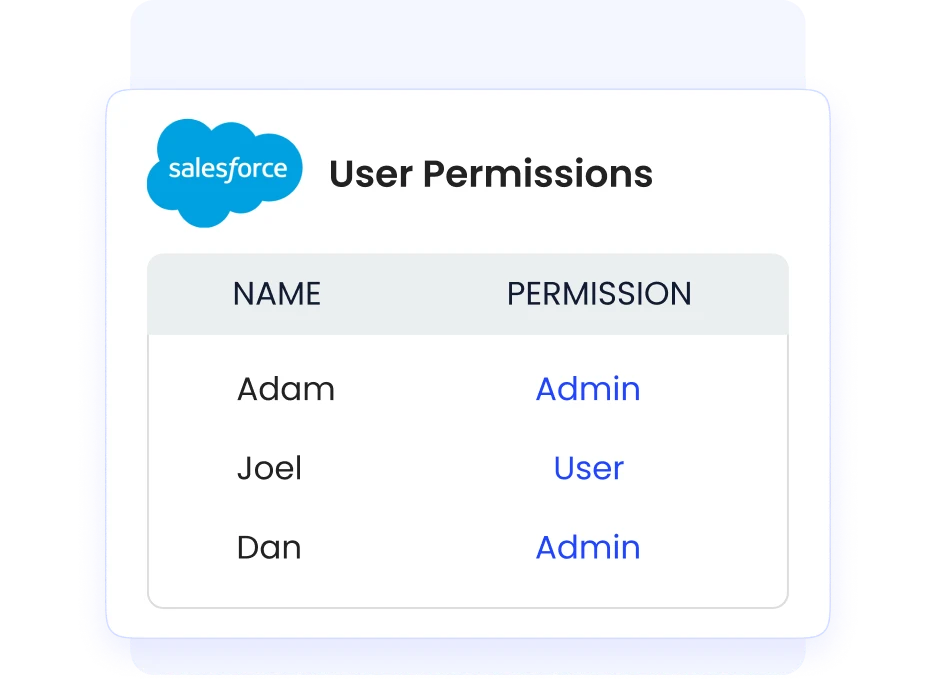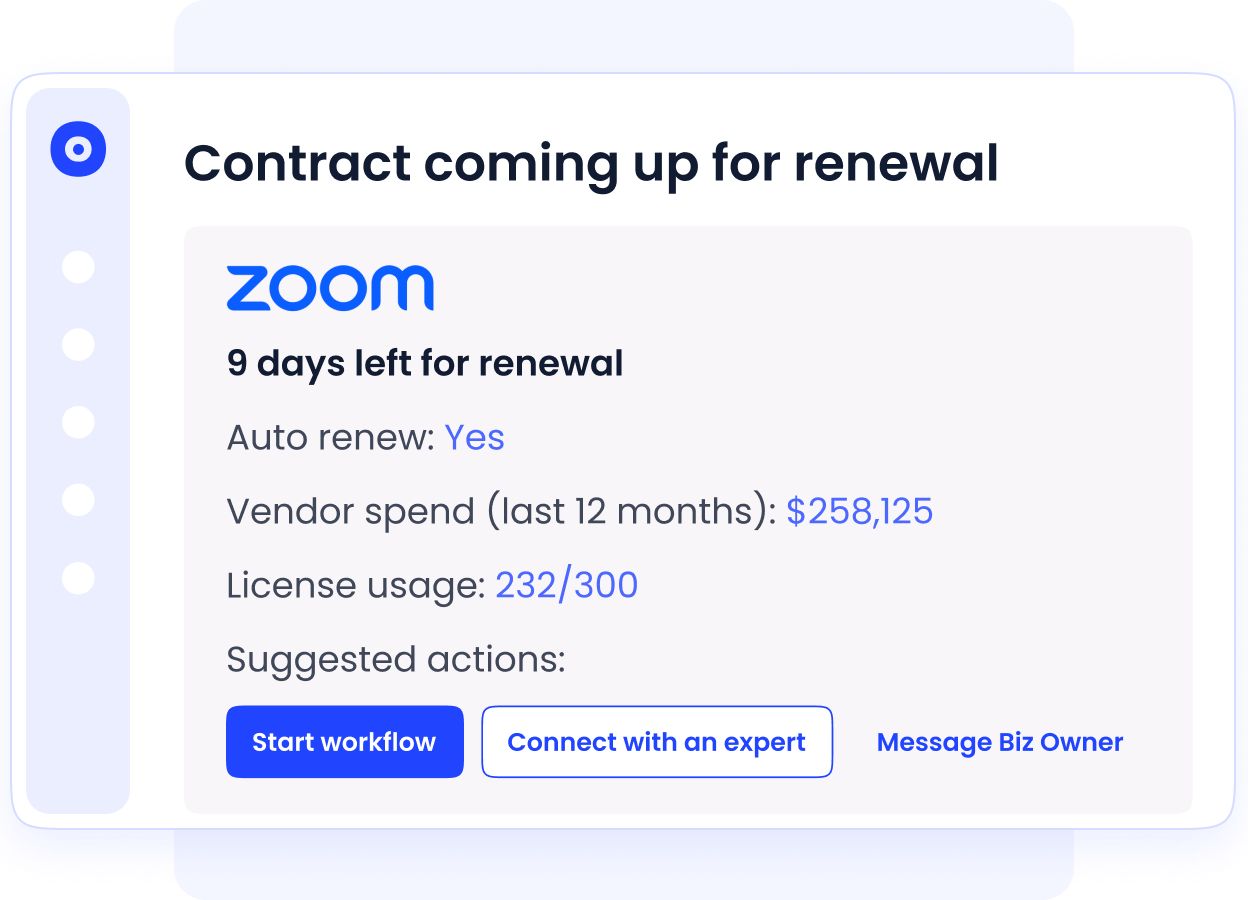HIPAA Compliance Checklist for 2025

In today’s SaaS-first world, procurement teams are tasked with selecting the best vendors for a wide range of software and services that are critical to business operations. With hundreds of tools available, choosing the right software can feel like an overwhelming task.
To streamline the vendor selection process, many procurement teams rely on a structured approach known as a Request for Information (RFI).
An RFI in procurement is the first step in vendor selection, helping businesses gather essential information about potential vendors before moving on to more detailed steps like a Request for Proposal (RFP) or Request for Quotation (RFQ).
This blog will explore what an RFI is, how it improves vendor selection, and why it is a crucial tool for procurement teams, particularly when evaluating SaaS vendors.
Additionally, we’ll discuss how CloudEagle.ai can enhance the RFI process, driving smarter and more data-driven procurement decisions.
1. TL;DR
- An RFI (Request for Information) is a preliminary procurement document used to gather high-level details about potential vendors before deeper evaluations.
- It helps procurement teams understand the market, filter unsuitable vendors early, and align internal stakeholders on requirements.
- RFIs differ from RFPs and RFQs, RFI = explore options, RFP = detailed proposals, RFQ = pricing.
- A strong RFI includes vendor background, product overview, technical/security needs, pricing models, and support details to standardize evaluations.
- CloudEagle.ai enhances the RFI process through automated SaaS discovery, vendor comparison, usage insights, compliance checks, and price benchmarking for smarter vendor selection.
2. What is an RFI in Procurement?
A Request for Information (RFI) is a formal document used by organizations to collect general information about potential suppliers or vendors. The purpose of an RFI is not to make final vendor decisions, but rather to gather high-level details about vendors' capabilities, solutions, and services.
An RFI typically serves as the first step in the procurement process. It allows procurement teams to understand what options are available in the market, compare vendor offerings, and filter out vendors that don’t meet basic requirements.
RFIs can be used for a wide range of procurement needs, from software and technology tools to services and equipment.
The RFI provides valuable insights that help teams create a shortlist of vendors to move forward with, often leading to the issuance of an RFP or RFQ for more detailed evaluation.
Why Use an RFI?
The primary reason organizations issue an RFI is to gather structured information from potential vendors in a clear, standardized way. An RFI helps procurement teams:
- Identify qualified vendors early in the process, avoiding wasted time on suppliers that don’t meet requirements.
- Gather high-level information about vendor capabilities, experience, and offerings.
- Align internal stakeholders on key requirements and selection criteria.
- Set the stage for the RFP or RFQ process, ensuring that only vendors who can meet basic criteria are invited to provide a more detailed proposal or quotation.
In the world of SaaS procurement, where companies may manage hundreds of subscriptions, the RFI can also help evaluate software vendors on key metrics like functionality, integration capabilities, security features, and cost efficiency.
3. RFI vs RFP vs RFQ Explained: Key Differences Every Procurement Team Should Know
The terms RFI, RFP, and RFQ are often used interchangeably, but they refer to different stages in the procurement process. Understanding the differences between these terms is critical for procurement teams looking to run an effective vendor selection process.
What is an RFP?
A Request for Proposal (RFP) is issued when an organization is ready to formally evaluate potential suppliers in detail.
Unlike an RFI, which collects high-level information, an RFP asks vendors to submit a detailed proposal that outlines their solution, pricing, delivery timeline, and other critical information.
RFPs are typically issued after an RFI has been completed, as the information gathered in the RFI process helps the procurement team identify which vendors are the most suitable for further evaluation.
RFPs are more detailed and often involve a formal bidding process, where vendors are evaluated based on several criteria such as price, features, technical requirements, and compliance.
What is an RFQ?
A Request for Quotation (RFQ) is a more specific request than an RFP and is typically used when a buyer has clearly defined their needs and wants detailed pricing information from potential vendors.
RFQs are often used for products or services that are standardized, where the buyer can make a purchasing decision based on price alone.
4. Key Differences Between RFI, RFP, and RFQ
5. Why RFIs Are Important in Vendor Selection
RFIs play a critical role in improving the vendor selection process by providing procurement teams with a standardized and structured way to evaluate vendors. By issuing an RFI early in the procurement process, organizations can avoid wasting time on vendors that don’t meet their basic requirements. Here’s why RFIs are essential:
1. Helps Define the Market
RFIs provide valuable insights into the market landscape. By reaching out to multiple vendors, procurement teams can get a sense of the different offerings available, the latest trends, and the strengths and weaknesses of each vendor’s solution.
This is particularly important in SaaS procurement, where the range of software products can be overwhelming.
2. Saves Time and Resources
Issuing an RFI allows procurement teams to narrow down their options early. Rather than spending time on a deep evaluation of every vendor, RFIs help identify the vendors that meet basic requirements, allowing teams to focus their efforts on more qualified vendors.
This reduces the time spent evaluating unsuitable solutions.
3. Aligns Stakeholders
An RFI ensures that all relevant stakeholders, from IT to procurement to finance, are aligned on key requirements and expectations before moving forward with more detailed evaluations.
This alignment helps avoid delays later in the process when the team discovers that the selected vendor doesn’t meet critical needs.
4. Improves Decision-Making
By providing a structured framework for vendor evaluation, an RFI enables procurement teams to make more informed decisions. Vendors submit their responses based on the same set of criteria, which makes it easier to compare their capabilities, strengths, and weaknesses.
This reduces bias and improves the overall quality of the vendor selection process.
6. What Should an RFI Include?
An RFI document should be structured to collect all relevant information from potential vendors. A well-designed RFI ensures that the responses are comparable and provide the necessary details for the procurement team to make informed decisions.
Key components of an RFI include:
1. Introduction and Company Background
This section provides an overview of the organization issuing the RFI, including the purpose of the RFI, the scope of the project, and any high-level requirements. It may also include a brief description of the organization’s goals for the procurement process.
2. Vendor Information
This section gathers key details about the vendor, such as their company history, years in business, financial stability, and references. It helps the procurement team evaluate the vendor’s experience and credibility.
3. Product/Service Overview
Vendors should provide a detailed description of their solution, including its features, capabilities, and any unique selling points. In SaaS procurement, this section should also include details about integrations, scalability, and customization options.
4. Technical Requirements
Technical requirements outline the key features that the solution must have, such as security standards, compliance certifications, and compatibility with existing systems. This section ensures that the solution meets the organization’s technical needs.
5. Pricing Information
While the RFI is not focused on final pricing, vendors should provide a general sense of pricing models, including any subscription or licensing fees, setup costs, and ongoing maintenance or support fees. This helps procurement teams assess whether the vendor’s pricing aligns with the organization’s budget.
6. Support and Implementation
Vendors should describe their customer support offerings, including response times, escalation procedures, and support channels. They should also provide an implementation timeline and explain the training and onboarding process.
7. How to Create an Effective RFI
Creating an effective RFI requires clear objectives, collaboration with internal stakeholders, and a well-structured document. Here’s a step-by-step guide to creating an RFI:
Step 1: Define What Information You Need
Start by determining what information is necessary to make an informed decision. What are your technical, financial, and security requirements? What are your goals for the project? Defining these objectives will help you craft the right questions.
Step 2: Collaborate With Internal Teams
Work closely with internal teams such as IT, legal, security, and finance, to ensure that the RFI captures all relevant requirements. This collaboration helps ensure that the RFI aligns with your organization’s broader strategic goals.
Step 3: Draft Clear and Relevant Questions
The questions in your RFI should be clear and relevant to the procurement process. Avoid asking too many questions or making them too complex. Focus on the key information that will help you evaluate vendors.
Step 4: Distribute and Track Vendor Responses
Once the RFI is finalized, distribute it to potential vendors and set a deadline for responses. Use a centralized system to track responses and ensure that you can easily compare vendor submissions.
Step 5: Compare and Shortlist Vendors
After receiving the RFI responses, evaluate each vendor based on the predefined criteria. Shortlist the most suitable vendors for the next stage of the procurement process (e.g., issuing an RFP).
8. How RFIs Improve Vendor Selection
RFIs streamline the vendor selection process by providing structured, comparable data that enables better decision-making. By using an RFI, procurement teams can:
- Ensure data-driven decisions, reducing subjective biases and making the selection process more objective.
- Standardize the evaluation process, making it easier to compare vendors based on the same criteria.
- Avoid overpaying for features that are not required, as vendors must outline their solution’s features and pricing clearly.
Using RFIs in SaaS Procurement
In SaaS procurement, RFIs are especially valuable because they help evaluate vendors on key aspects such as:
- Pricing models: Understanding whether the vendor uses a subscription-based model or charges based on usage or seats.
- Security and compliance: Ensuring that the vendor meets industry standards for data security, privacy, and regulatory compliance.
- Integration capabilities: SaaS solutions must often integrate with existing tools, so it’s important to gather information on available integrations.
8. How CloudEagle.ai Supercharges Your RFI and Vendor Evaluation Process
An RFI lays the groundwork for choosing the right vendor, but CloudEagle.ai takes the entire sourcing and evaluation cycle to the next level. With AI automation, real-time intelligence, and unified visibility, it turns a traditionally manual, fragmented workflow into a fast, consistent, and insight-driven process.
1. Accelerate Vendor Discovery and Shortlisting

CloudEagle’s Discover pillar gives procurement teams a complete, real-time view of their SaaS ecosystem and the broader vendor landscape. Instead of spending hours researching suppliers, teams get instant access to accurate, enriched vendor data.
What it enables:
- Automatically detects all existing tools and overlapping vendors
- Surfaces alternative solutions by category, pricing, and capability
- Analyzes usage, spend, and adoption patterns across applications
- Flags redundant tools to refine and narrow the RFI scope
This helps teams quickly shortlist the most relevant vendors before the RFI even begins.
2. Consolidate Security & Compliance Due Diligence
CloudEagle’s Govern pillar centralizes all vendor-related security and compliance information, simplifying one of the most time-consuming parts of the RFI process.

CloudEagle centralizes:
- SOC 2, ISO, GDPR, HIPAA and other certification documents
- Security questionnaire responses
- Vendor risk assessments and data-sharing insights
- User access governance and lifecycle data
- OAuth permissions and integration visibility
This eliminates siloed due-diligence work and ensures vendors meet baseline security standards early in the evaluation
3. AI-Powered Vendor Comparisons for Clear Decisions
CloudEagle generates structured, AI-driven comparison pages that provide a holistic, apples-to-apples view of every vendor under consideration.

Comparisons include:
- Product capabilities and feature gaps
- Adoption and usability predictions
- SLAs, contract terms, and pricing structures
- Renewal risks and past spend trends
- Security maturity and compliance readiness
Procurement, IT, security, and finance teams get a single, unified view to make confident, data-backed decisions.
4. Standardized Templates and Automated Workflows
CloudEagle brings structure and consistency to sourcing through prebuilt templates and automated workflows that remove repetitive manual work.
Templates include:
- RFI documents
- Vendor evaluation scorecards
- Renewal readiness checklists
- Security and compliance assessment forms
- Intake-to-procure approval flows
Workflow automation:

- Auto-routes requests to IT, Legal, Security, and Finance
- Collects and organizes RFI responses in one place
- Generates complete audit trails automatically
This standardization reduces bottlenecks and improves governance across the procurement lifecycle.
5. Real-Time Pricing Benchmarks & Negotiation Intel

Using data from 150,000+ SaaS transactions and 500+ integrations, CloudEagle’s Optimize pillar delivers unmatched pricing intelligence.
Teams gain access to:
- Up-to-date pricing benchmarks
- Discount benchmarks and trends
- Recommended negotiation plays
- Renewal cost forecasts
- Vendor-switching and cost comparison insights
This ensures every RFI leads to financially optimized outcomes, not guesswork.
6. Smarter and More Predictable Renewals

CloudEagle’s Renew pillar extends evaluation beyond selection, giving teams visibility and control well before renewal deadlines.
Capabilities include:
- Automated alerts 90–120 days before renewal
- Renewal-readiness dashboards
- Usage insights for accurate right-sizing
- Proactive suggestions for alternative vendors
- One-click negotiation support
This minimizes last-minute pressure and sets teams up for strategic, cost-effective renewals.
9. Conclusion
RFIs are a crucial step in the procurement process, allowing organizations to gather high-level information about potential vendors and make informed decisions. By issuing an RFI, procurement teams can streamline the vendor selection process, align stakeholders, and ultimately select the best vendors for their needs.
CloudEagle.ai further enhances this process by providing visibility into existing software stacks, streamlining vendor evaluations, and ensuring smarter, more cost-effective vendor selections. With CloudEagle.ai, organizations can optimize their SaaS procurement process, improving efficiency and ensuring they get the best value from their vendors.
FAQs
1. What is an RFI in procurement?
An RFI is a discovery tool that helps organizations validate whether a vendor understands their problem space. It’s often used to gather strategic insights, industry perspectives, and solution approaches, not just product details.
2. How does an RFI improve the vendor selection process?
RFIs reduce the risk of choosing the wrong vendor by revealing how vendors think, how mature their processes are, and whether they can scale with future needs. This early clarity prevents costly misalignment later in the procurement cycle.
3. What’s the difference between an RFI, RFP, and RFQ?
Think of them as stages of commitment:
- RFI = explore possibilities
- RFP = evaluate structured solutions
- RFQ = confirm pricing for a defined scope
Organizations use them sequentially to avoid jumping into pricing conversations before understanding the landscape.
4. What should be included in an RFI?
Beyond basic vendor information, RFIs increasingly include questions around innovation roadmap, data governance practices, customer success model, and long-term product stability, factors that influence vendor viability more than just features.
5. When should an organization issue an RFI?
RFIs are most effective when entering emerging categories (e.g., AI tools, security platforms) where offerings differ widely. They’re also useful when internal teams disagree on requirements and need external inputs to refine their needs.

%201.svg)








.avif)




.avif)
.avif)




.png)









